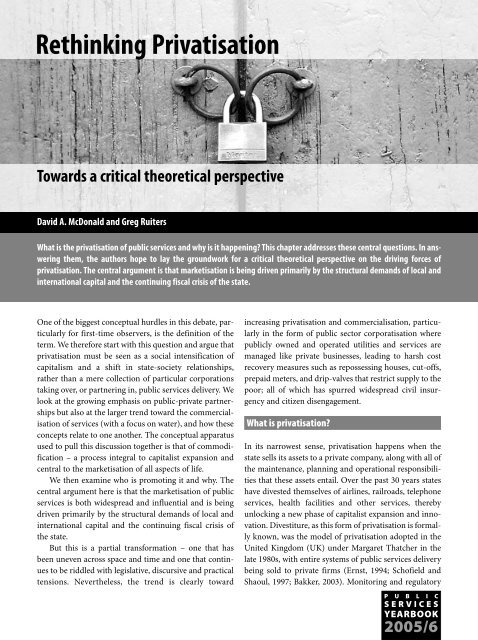Rethinking Privatization Towards a Critical Theoretical Perspective
Rethinking Privatization Towards a Critical Theoretical Perspective
Rethinking Privatization Towards a Critical Theoretical Perspective
You also want an ePaper? Increase the reach of your titles
YUMPU automatically turns print PDFs into web optimized ePapers that Google loves.
<strong>Rethinking</strong> Privatisation<strong>Towards</strong> a critical theoretical perspectiveDavid A. McDonald and Greg RuitersWhat is the privatisation of public services and why is it happening? This chapter addresses these central questions. In answeringthem, the authors hope to lay the groundwork for a critical theoretical perspective on the driving forces ofprivatisation. The central argument is that marketisation is being driven primarily by the structural demands of local andinternational capital and the continuing fiscal crisis of the state.One of the biggest conceptual hurdles in this debate, particularlyfor first-time observers, is the definition of theterm. We therefore start with this question and argue thatprivatisation must be seen as a social intensification ofcapitalism and a shift in state-society relationships,rather than a mere collection of particular corporationstaking over, or partnering in, public services delivery. Welook at the growing emphasis on public-private partnershipsbut also at the larger trend toward the commercialisationof services (with a focus on water), and how theseconcepts relate to one another. The conceptual apparatusused to pull this discussion together is that of commodification– a process integral to capitalist expansion andcentral to the marketisation of all aspects of life.We then examine who is promoting it and why. Thecentral argument here is that the marketisation of publicservices is both widespread and influential and is beingdriven primarily by the structural demands of local andinternational capital and the continuing fiscal crisis ofthe state.But this is a partial transformation – one that hasbeen uneven across space and time and one that continuesto be riddled with legislative, discursive and practicaltensions. Nevertheless, the trend is clearly towardincreasing privatisation and commercialisation, particularlyin the form of public sector corporatisation wherepublicly owned and operated utilities and services aremanaged like private businesses, leading to harsh costrecovery measures such as repossessing houses, cut-offs,prepaid meters, and drip-valves that restrict supply to thepoor; all of which has spurred widespread civil insurgencyand citizen disengagement.What is privatisation?In its narrowest sense, privatisation happens when thestate sells its assets to a private company, along with all ofthe maintenance, planning and operational responsibilitiesthat these assets entail. Over the past 30 years stateshave divested themselves of airlines, railroads, telephoneservices, health facilities and other services, therebyunlocking a new phase of capitalist expansion and innovation.Divestiture, as this form of privatisation is formallyknown, was the model of privatisation adopted in theUnited Kingdom (UK) under Margaret Thatcher in thelate 1980s, with entire systems of public services deliverybeing sold to private firms (Ernst, 1994; Schofield andShaoul, 1997; Bakker, 2003). Monitoring and regulatoryP U B L I CSERVICESYEARBOOK2005/6
oversight in this model of privatisation remain a responsibilityof the state, however, or a parastatal regulatorybody.The privatisation of services in other parts of theworld does not necessarily follow the UK model though.Most municipal privatisation schemes today do notinvolve any transfer of state assets, focusing instead onthe transfer of operational and managerial functions toprivate companies (e.g. meter reading, personnel management,strategic planning, maintenance).Infrastructure and equipment typically remain in publichands – or are transferred back to public ownership aftera specified period – and there may be joint responsibilitiesbetween the state and a private firm in managingoperational functions. This model is used across theworld by leading water firms such as Suez and Veolia(formerly known as Vivendi Environnement), whichoperate this way in over 12.000 towns and cities(Goubert, 1986; Hanke, 1987; Lorrain, 1991; Kerf, 1998).More properly known as ‘private sector participation’(PSP) or, as will be used in this chapter, ‘public-privatepartnerships’ (PPPs), these institutional arrangementsare nevertheless a form of privatisation. There is a cleartransfer of crucial decision making responsibilities fromthe public to the private sector and an effective transfer ofpower over assets to a private company, with qualitativelyand quantitatively different rules and regulations guidingthe decisions that are made and how citizens are ableto access information. This broader definition of privatisationis also accepted by leading international agenciessuch as the World Bank, the World Health Organisation,the Water Supply and Sanitation Collaborative Counciland various United Nations–related agencies who haveactively promoted PPPs in public services in the South,such as the United Nations Development Programme,UN-HABITAT and UNICEF (see, for example, Lorrainand Stoker, 1997; Kerf, 1998; World Bank, 1994, 1997,2003; WHO and UNICEF, 2000; UNDP-World Bank,1998).It is also important to note that PPPs can range fromsmall operations, such as one-person contractors whorepair pipes in an informal urban settlement, to a largemultinational company hired to manage the provision ofbulk water and sanitation for an entire city. The size andtypes of contracts can vary as well, from short-term, feefor-servicecontracts, to 30-year licenses. Although largewater service multinationals like Suez, Veolia, RWEThames, and (until recently) Bechtel tend to attract themost attention when it comes to water privatisationdebates, small firms and ‘entrepreneurs’ represent a largepart of the privatisation thrust, with these micro-enterprisedeals often going unnoticed by the public. Thissmaller, ‘creeping’ form of privatisation is as much a topicof interest as the large multinational efforts to take overentire water systems.Less easy to classify are forms of privatisation thatinvolve the downloading of service responsibilities toindividuals, communities and nongovernmental organisations.Represented in the neo-liberal literature as ‘activecitizenship’ (Burrows and Loader, 1994) and ‘communityempowerment’ – a counter to welfare dependency(Wolch and Dear, 1989) – this transfer of decision makingand responsibility also constitutes a move from thepublic (i.e. the state) to the private (in this case an individualor community). Although not necessarily actingwith the same institutional or economic incentives andframeworks as a private company, the transfer of decisionmaking power to individuals and communities neverthelessconstitutes an abdication of responsibilities on thepart of the state.Table 1 provides a typology of privatisation arrangements.Most agreements are hybrids of these categories,of course, tailored to suit the specific situation of individualgovernments and companies, but it should be clearfrom the table that all privatisation schemes involve someform of public and private sector participation.Privatisation, in other words, is not an either/or situation(either the state owns and runs a service or the private/communitysector does). Privatisation must be seenas a continuum of public and private mixes, with varyingdegrees of involvement and exposure to risks by the twosectors (see Starr, 1988). It is a conceptual and politicalmistake to pose the market (private) and the state (public)as binary opposites on this issue.Moreover, as Bakker (2003:4-36) has argued in thecase of the UK, even the outright divestiture of stateassets can, ironically, mean greater state involvement inservices, prompting her to employ the term ‘re-regulation’rather than ‘deregulation’ in regards to legislativechanges that allow for greater private sector involvementin public services: “a process in which the state has reconfiguredits role, and in some instances expanded its powersand administrative reach (…) the state does not necessarilywithdraw, but rather changes the nature of its interactionwith citizens and corporations.”The term privatisation is therefore used here as a10
Table 1. Different Forms of PrivatisationFull DivestitureService ContractDivestiture refers to a situation where a public utility or service has been fully privatised. Ownership restswith the private operator. The private operator is responsible for operation and maintenance, investmentsand tariff collection. The private utilities operate under the supervision of an independent publicregulatory authority.This is the least risky of all partnership types. The public authority retains responsibility for operation andmaintenance of the service, but specific components of the service (for example operating water treatmentworks or billing) are contracted out to the private sector. Service contracts usually have a durationof one to two years, due to the fact that the problems they address may be unique and short-lived. Thelocal authority does not relinquish any managerial functionsPART I: Chapter 1 - <strong>Rethinking</strong> PrivatisationManagement ContractLease or AffermageConcessionThe management contractor operates and maintains the service or parts of the service and may alsoundertake to reshape the system. The public authority monitors the private agent, but remains responsiblefor new investment. Management contracts tend to cover a time-span of two to ten years.The lessor rents the facility from the public authority, which transfers complete managerial responsibilityfor operating and maintaining the system to a private company. Such contracts generally have a durationin excess of ten years. The contract specifies reporting requirements and service standards. Payments aresplit into fixed and volume related amounts. (Affermage is the French term for 'farming out.')In this investment-linked contract the concessionaire has overall responsibility for the services, includingoperation, maintenance, and management as well as capital investments during the concession period.The concessionaire is also responsible for tariff collection and 'customer management.' The ownership offixed assets is assigned to the local authority at the end of the contract. The contract, usually signed aftercompetitive bidding, covers a period of 25 to 30 years. Regulation is by contract.BOOTBuild, Own, Operate and Transfer contracts are generally used to construct new parts of a service system.The private operator builds the facility and assumes responsibility for operation and maintenance. Aftera predetermined time the facility is transferred to the public authority. The length of a BOOT contract istypically 25 years.Community / NGO provisionCommunity and nongovernmental organisation (NGO) provision - an often neglected form of privatisation- involves the transfer of some or all of the responsibility for service provision to the end user or anot-for-profit intermediary body. This is particularly common in low income, urban settlements in theSouth where local governments have asked community members and community organisations to supplementweak or nonexistent facilities or resources with their own labour (e.g. digging wells, laying orrepairing pipes). Women tend to carry the burden of this form of privatisation. NGOs play a key role aswell, often taking on management and allocation responsibilities.11
generic expression for a range of private sector involvementsin service delivery rather than a single state ofbeing. This is done in part because the term privatisationis widely recognised in popular discourse (as opposed to‘public-private partnerships’) and in part because it highlightsthe fact that assets and/or decision making responsibilitieshave passed from public to private hands.But we cannot limit our discussion of privatisation todirect private sector participation and control. Equallyimportant is the question of private sector operatingprinciples and mechanisms. The ‘commercialisation’ ofservices in the formally designated public sector is criticalto our understanding of public services reforms. Thenext section describes commercialisation (and its mostcommon institutional variant, ‘corporatisation’) and discussesits links – mechanically and conceptually – to privatisation.The meanings of commercialisationand corporatisationCommercialisation refers to a process by which marketmechanisms and market practices are introduced intothe operational decision making of a public service – e.g.profit maximisation, cost recovery, competitive bidding,cost-benefit analysis, performance targeted salaries,ringfenced decision making, demand-driven investments,etc. (Stoker, 1989; Pendleton and Winterton,1993; Dunsire, 1999; Leys, 2001; Olcay-Unver et al,2003). This is in opposition to the more traditional publicsector operating principles of integrated planning,(cross) subsidisation, supply-driven decision making,equity orientation, and so on (keeping in mind that thereare no ideal or absolute types here – i.e. commercial principlesand more traditional public sector managementprinciples can run concurrently, to varying degrees).A popular institutional form of commercialisation iscorporatisation, where services are ringfenced intostand-alone ‘business units’ owned and operated by thestate but run on market principles. Corporatisationinvolves two major organisational shifts. The first entailsfinancial ringfencing, whereby all resources directlyinvolved in the delivery of a service are separated from allother service functions (e.g. personnel in water are separatedout for accounting purposes from personnel inwaste management and are not allowed to do work forthe other unit). Where resources are shared by more thanone department (e.g. information technology, vehicles)the ringfenced entity pays the other unit a full-cost fee forthe use of those resources (see Shirley, 1999; PWC, 1999;PDG, 2001; Whincop, 2003; Bollier, 2003).The purpose of this financial ringfencing is to createa transparent form of accounting where all costs and revenuesrelated to the service can be identified, along withany subsidies in and out of the ringfenced unit. This isintended to reveal the real costs/surpluses of running aservice and allows managers to identify areas of financialloss/gain that may have otherwise been hidden in theintricate accounting systems and cross-subsidisationmechanisms of an integrated service delivery schemewith centralised accounting. Financial ringfencing alsocreates an opportunity to introduce financially drivenperformance targets for managers (i.e. managers arerewarded for meeting loss/profit targets). This approachintroduces market-based salaries for managers with theaim of attracting ‘world class’ executives who are expectedto pay their way by ensuring that the bottom line ispositive.The second aspect of corporatisation is managerialringfencing – the creation of separate business unitsmanaged by appointed officials operating at arms lengthfrom the public authority. Elected officials still set standardsand service delivery goals for a corporatised serviceunit, as well as monitor and evaluate its activities, butthe daily management and long-term planning of theunit are done by the ringfenced management team.What is the link between corporatisation and privatisation?First and foremost is the change in managementethos with a focus on a narrow and increasingly shorttermfinancial bottom line. So complete can this shift inmanagement culture be that utilities and services whichare fully owned and operated by the state (i.e. consideredto be fully ‘public’) can be more commercial than their‘privatised’ counterparts, with managers aggressivelypromoting and enforcing cost recovery and other marketprinciples.Second, corporatisation often promotes outsourcingas an operating strategy and discreet form of cost-cutting.A competitive operating environment, in turn,requires deregulating (or re-regulating) monopolisticcontrol of the service and allowing multiple serviceproviders to compete with the ringfenced unit to providea particular service at cost-effective prices (e.g. meterreading). The removal of subsidies, for instance, forcesstate-owned enterprises to compete for finance on anequal basis with private firms or other corporatised enti-12
ties. In some cases, the corporatised entity may have tocompete with a private firm for the management of aservice.Third, corporatisation can act as a gateway for directprivate sector investment, ownership or control by makingpublic services more attractive to the private sector.Private companies, after all, are not interested in buyinginto services with intricate and/or hidden cross-subsidisationstructures, inflexible and politically integrated decisionmaking procedures, or anti-market managementcultures. Public services that have been delineated fromother service functions with clearly defined costs andrevenue structures, with some form of managerial autonomy,and with market oriented managers are much morelikely to attract interest from private firms.Not all corporatisation efforts are mere preparationfor bigger privatisation plans, but this is a real – andgrowing – motivation for governments that are adoptingthe corporatisation model. As one senior manager interviewedin Cape Town about that city’s plans to corporatiseits water services remarked (McDonald and Smith2002:32):Lyonnais des Eaux has come knocking on my door ontwo occasions. These French water companies havebecome too powerful to resist. The takeover isinevitable. I want to run our services like solid businessunits to make sure that we negotiate from a position ofstrength when it does happen.Commercialisation therefore paves the way for privatesector involvement in public services and/or createspublicly owned and operated systems that behave, for allintents and purposes, like a private sector provider, mimickingbusiness discourses and practices and serving to‘hollow out’ the state (Stoker, 1989; Clarke and Newman,1997; Dunsire, 1999; Taylor-Gooby, 2000).Commodification of servicesTying all of this together are the underlying processes ofcommodification. Only when public services are treatedas a commodity can they be effectively commercialisedand, eventually, privatised. It is at this politico-economicjuncture that we see the full significance of such a transformationemerge: e.g. water stripped of its image as anabundant, nature-provided good for public benefit, towater as a scarce, monetised entity subject to the samelaws and principles of the market as shoes, lampshades,or computers.Only by examining these processes of commodificationcan we go beyond the narrow institutional and operationaldefinitions of privatisation and commercialisationdescribed above and more fully appreciate the transformativeeffects of treating public services as a privategood. Privatisation and commercialisation must be seenas part of this wider process of intensified and extensifiedcapitalism.We start by examining neoclassical definitions ofcommodity and commodification, partly because thesedefinitions have been so influential and dominate publicdiscourse on the topic but also because they are nowbeing used to justify privatisation and commercialisationof public services.A commodity, in neoclassical economic terms, is anythingthat can be bought and sold in the marketplace inexchange for another commodity or for money.‘Commodification,’ therefore, is any act, practice or policythat promotes or treats a good or service as an articleof commerce to be bought, sold, or traded through markettransactions (Watts, 1999; Brown, 2003; Williams andWindebank, 2003). According to neoclassical theory, tobe commodified, a good or service must have the characteristicsof a ‘private good’: it must be rival in its consumption(i.e. one person’s consumption of that gooddenies consumption by another person – for example, achocolate bar) and it must be excludable (people can bedenied access if they do not pay – for example, admissionto a movie). Private goods can therefore be priced forindividual consumption and respond well to market signals.‘Public goods,’ on the other hand, resist commodificationbecause they are non-excludable (i.e. people cannotbe prevented from using a good or service becausethey did not pay for it – e.g. clean air) and non-rival (i.e.consumption by one person does not diminish theamount available for the next person – e.g. street lighting).According to neoclassical theory public goods andservices are unlikely to be provided by a private firmunder market conditions because they are prone to ‘freeriders,’ making it too risky for a private firm to invest inproducing them.Services such as water, in neoclassical theory, liebetween these two poles, being neither a pure privategood nor a pure public good, sometimes referred to inthe neoclassical literature as a ‘merit good’ (Neutze,PART I: Chapter 1 - <strong>Rethinking</strong> Privatisation13
pressures to commodify (Harvey, 1990, 2003), commodificationis not necessarily a linear or inevitable process.Nevertheless, we have seen a steady expansion of marketrelations and commodification around the world overthe past few centuries, with remarkable acceleration inthe past few decades. Commodification may not be complete,and it may not be inescapable, but “the reality ofcapitalism is that ever more of social life is mediatedthrough and by the market” (Watts, 1999:312).Here we see corporatisation as the logic of commodificationpar excellence: the compartmentalisation of allhitherto integrated service functions into stand-alone,cost recovery units; the homogenisation of measurementand reward structures; and the increasingly narrow focuson a financial bottom line. Corporatisation may not bethe same as privatisation in the narrow, ownership sensedescribed at the outset of this chapter, but it does serve toembed market logics into all aspects of the decision makingprocess about public services delivery, and results inmany of the same outcomes.There are several lessons to be drawn from this line ofargument. First, goods and services are not inherently‘public’ or ‘private’ according to some innate set of physicalcharacteristics (as neoclassical theorists would haveus believe). The commodification of a good or service isa socially and historically constructed phenomenon thatcannot be understood outside of its relationship to agiven set of social relations of production.Second, commodification is not – as some criticsearnestly but mistakenly infer – simply an act of attachinga price to a good or service that used to be providedfor free. Commodification is a systemic and comprehensivetransformation of our material lives; price is merelyits external appearance.Third, to call for the ‘decommodification’ of servicessuch as water – as many anti-privatisation critics do byarguing that they should be provided for free – is to callfor nothing less than the rupturing of the social relationsthat contributed to its commodification in the first place,a radical (and commendable) idea but one that is sometimesunintended by its proponents.The last and most important point is that commodificationis the driver of privatisation, commercialisationand corporatisation. It is, ultimately, the process thatfacilitates a transfer of ownership and control ofresources from public to private hands. At the very least,commodification creates the conditions for goods andservices to be captured by the logic of the market, with allof the concomitant inequities and multi-tiered standardsthat this entails. These are the cascading effects of commodificationand they are inherent to all capitalisteconomies.Nevertheless, we must distinguish between differentinstitutional forms of marketisation and acknowledgethat ownership of assets does matter. In other words, apublicly owned, corporatised system is different than aprivately owned system, if not in the fundamentals of itspractice then at least in terms of the potential public controlover their operation. But we cannot ignore the factthat the commodification process slowly erodes the differences.Whether, and how long, public services canresist these broader commodification pressures, and stayin public hands, remains to be seen.Why is it happening?The question of why privatisation and commercialisationof public services is taking place is a hotly contested one.Neoliberal analysts have argued that privatisation occursbecause states fail: state officials are rent-seeking, inefficient,unaccountable, inflexible and unimaginative.Privatisation is seen as a rational and pro-poor policychoice, obvious to anyone willing to look at the trackrecord of public versus private sector delivery:“Privatisation really works,” says the World Bank(2000:5). “Consumers are not bothered about economicphilosophy – they just want better service at lower prices.”Hodge (2000:35–46), in his review of the privatisationliterature, identifies five core theories that have beenused to explain the privatisation phenomenon (internationallyand across all sectors): public choice theory,agency theory, transaction cost analysis, new public management,and property rights theory. Although differentin their individual foci, all have at their core the beliefthat people respond best to market incentives and thatmarket-based systems are inherently more efficient andmore transparent than traditional public sector arrangements.“[W]e have witnessed a renewed cultural enthusiasmfor private enterprise,” he argues, spurred on by “adeficit-induced imperative to limit government spending”(Hodge, 2000:35).We argue, by contrast, that the privatisation of publicservices has not happened because it has been inspired bysome renewed sense of cultural enthusiasm for the market,but rather that it has become a necessity imposed onthe state by economic circumstances (Meszaros, 1998):PART I: Chapter 1 - <strong>Rethinking</strong> Privatisation15
educed public borrowing; cuts in state spending; liberalisation;and the opening up of new economic fields forintensified capital accumulation.It is possible to trace this shift historically in the watersector. As economies and the construction of new damsshrank in the 1970s, competition for opportunities in thewater sector intensified. This happened at the same timeas the state, under fiscal pressure, could no longer keepup spending levels on new infrastructure or in maintainingthe old. The privatisation of downstream activities –traditionally done by the state – offered new businessoptions, and even if these were risky, contracts could bedesigned to make them less so. For the water and engineering-constructionindustry, privatisation was seen asa way to absorb idle productive capacity and excess commodities(see Harvey, 1982).The strongest states have now made privatisation andopening up markets to their companies a condition offoreign aid. When the US bailed out Mexico in 1994 oneof the conditions for the loan was more rapid privatisation– i.e. Mexico had to absorb even more exports of UScapital (Moody, 1997). Similar conditionalities are beingapplied by the US to Iraq, with a USD 680 billion contracthaving been awarded to American-owned Bechtel in2003 for service delivery management and upgrades inthat country.Nowhere in the mainstream literature on privatisationis there recognition of the argument that privatisationand commercialisation are a response to the pressuresof an ever-expanding marketisation of social relationsunder capitalism. Nor is there any discussion inmainstream debates of the radical thesis that capitalistsmust constantly seek new geographic and sectoral areasof investment as a response to capital overaccumulation,or that capitalists are constantly forced to (re)create thephysical means of production through the creation (anddestruction) of built environments that facilitate marketexpansion. Privatisation, argues David Harvey(2003:149–50), “has, in recent years, opened up vast fieldsfor overaccumulated capital to seize upon (….) The neoliberalproject of privatisation of everything makes a lot ofsense as one way to solve the problem.”For global capital seeking new areas to commodify,and new sectors in which to invest overaccumulated capital,the public sector provides an enticing opportunity.With the water sector alone worth an estimated USD 1trillion in annual revenue (with only five to ten percent ofthe global water sector currently ‘privatised’), it is littlewonder that the services sector has attracted so muchattention from private capital. Water is particularlyattractive in this regard. As a non-substitutable good withlow elasticity of demand, and with the potential for rapidgrowth through network expansion, population increasesand the creation of boutique products such as bottledwater (now the second largest bottled beverage by sales inthe United States and growing rapidly internationally),water offers many advantages to oligarchic capital.The downside for capital is that this market in manyemerging economies has lost some of its sheen as privatefirms realize the risks of nonpayment in poor communitiesand the difficulties and expenses of building serviceinfrastructure in informal urban settlements and remoterural areas. In January 2003, Suez management issued apress statement saying that the company would have a“reduction of exposure to emerging countries by more thanone third as measured by capital employed [and wouldinstead be] focused on the most profitable and recurrentactivities within the global businesses.” In September 2005,Suez announced its intention to pull out of its AguasArgentinas concession, arguing that the company was nolonger in a position to assume the risks and responsibilitieslinked to the water and waste services operationsprovided to the city of Buenos Aires.Who is promoting privatisation?Not surprisingly, some of the biggest boosters of privatisationare the private companies themselves, which havespent considerable time and effort trying to secure newmarket opportunities. The large private firms haveactively sought contracts around the world by ‘knockingon doors’, flying bureaucrats to visit privatised concessionsin other countries, hosting workshops, producingglossy brochures, and sponsoring pro-privatisationresearch.But it is not just the international companies focusedon public services that stand to gain. Consultancy firmssuch as PriceWaterhouseCoopers and KPMG have beenactively promoting privatisation efforts, often acting asconsultants to local governments investigating their servicedelivery options (see, for example, McDonald andSmith, 2004). These same firms are also part of large proprivatisationconsortia in Europe and the United Stateslobbying for the expansion and acceleration of GATS.Local firms have also been promoters of privatisation.National and local Chambers of Commerce have been16
actively lobbying local governments in the South to privatiseservices because they are perceived to reduce taxburdens and/or offer contract opportunities for localentrepreneurs.Another set of privatisation promoters are the internationalfinancial institutions, most notably the WorldBank, which has been active in the South for decades andis arguably the single most influential body in the worldpromoting privatisation. Bond (2000) provides an indepth look at the role of the World Bank in promotingthe privatisation of water and other essential services inSouth Africa, from its first Mission Teams in the early1990s to its ongoing use of conferences and policy supportto win the ‘hearts and minds’ of policymakers.Similar efforts have been made by officials of the WorldBank and other development banks in other parts of theSouth. Most recently these development banks have beenheavily criticised for attaching conditionalities to theirlending, with direct and indirect pressures to commercialiseand/or privatise services (Grusky, 2001;Zandamela, 2001; ICIJ, 2003).The World Bank has also teamed up with the UnitedNations Development Programme (UNDP) to create theUrban Management Programme (now situated withinUN-HABITAT) which promotes private sector involvementin services. The UNDP has, in turn, established thePublic-Private Partnerships for the Urban Environmentprogramme, with an office in Namibia, mandated tointroduce the PPP idea into ongoing environmental andlocal governance programmes.Bilateral development agencies have also been a factor.USAID, for example, sponsored the formation of theMunicipal Infrastructure Investment Unit (MIIU) inSouth Africa in 1997, with the stated mission of “encourag[ing]and optimis[ing] private sector investment in localauthority services” (MIIU, 2000). Activities involve assistanceto local authorities in the process of hiring privatesector consultants and the management of contracts withthe private sector and ‘developing project proposalsinvolving private sector investment, including contractingout of the management of ongoing services; concessionsto operate the local authority’s assets over a definedperiod; contracts requiring the private sector to Design,Build, Finance and Operate assets to deliver services forthe local authority; privatisation of assets and services.The MIIU has provided advice and funding to dozens ofmunicipalities in the country, including the controversial30-year concession to run the water and sanitation systemsin Nelspruit and the five-year management contractin Johannesburg.Britain’s aid agency, DFID, has been actively promotingPPPs and private investment in public services aswell, through its Infrastructure and Urban DevelopmentDepartment. DIFD’s total expenditure on water-relatedprojects was GBP 87 million in 2001–02, about half ofwhich is channelled through pro-privatisation multilateralinstitutions such as the World Bank (Hansard, 2004).DFID has also hired what George Monbiot calls the“ultra-right wing” Adam Smith Institute to act as a consultanton privatisation, tasked with “telling countries likeSouth Africa how to flog off the family silver” (TheGuardian, January 6, 2004). Monbiot goes on to point outthat DFID spent GBP 56 million on assisting the governmentof Zambia to privatise its copper mines in 2003 butjust GBP 700,000 on improving nutrition in the country,and that in Ghana, DFID made its aid payments forupgrading the water system conditional on partial privatisation.Northern donor agencies are important actor supportingprivatisation. Germany’s aid agency, GTZ, hasbeen active in the promotion of water commercialisation,as has the Canadian International Development Agency(CIDA); the latter spending USD 4.2 million SouthernAfrica in 2003 to develop public-private partnershiptraining programs that will be taught in local institutionsthroughout the region, arguing that “public-private partnershipsare an important part of encouraging foreigninvestment in the region and promoting greater social andeconomic equity” (CIDA, 2002). Most, if not all, donoragencies operating in the South are supporting PPPefforts, either directly through bilateral funding or indirectlythrough support for multilateral agencies such asthe World Bank or pro-privatisation coalitions such asthe World Water Council.National and local governments and individualpoliticians and bureaucrats have been active promotersof privatisation as well. Legislative developments providea formal indication of this ideological orientation at thenational level but there are less formal expressions of thishegemony in the way of speeches, attendances at pro-privatisationconferences and openings of privately runservices. No less an authority than Nelson Mandela haspublicly endorsed prepaid water and electricity metersand the creation of public-private partnerships, going sofar as to say that “privatisation is the fundamental policyof our government” (as quoted in Pilger, 1998:606).PART I: Chapter 1 - <strong>Rethinking</strong> Privatisation17
Local governments, as the ‘hands and feet’ of servicedelivery, play a critical ideological and implementationalrole here. With decentralisation a defining feature ofmost political systems, local governments are increasinglychoosing some form of commercialisation or privatisation.National legislative frameworks and/or fiscalsqueezes often force local governments to opt for commercialisationor privatisation, but it is evident that localpoliticians and bureaucrats (not to mention localChambers of Commerce and small-scale entrepreneurs)are also ideologically committed to the marketisation ofservices. Local authorities are also active promoters ofcommercialisation, often working to convince their colleaguesin other municipalities that commercialisation isthe best policy choice, and organising regular pro-commercialisationworkshops and conferences.Local NGOs have been active promoters of privatisationtoo – such as Mvula Trust in South Africa – but thereare large international organisations that must be consideredhere as well. The World Water Council (WWC) –the self-proclaimed ‘International Water Policy ThinkTank’ – is an umbrella organisation that develops proprivatisationpolicy directions for water resources management,and advises on policy matters for decision makingbodies. Organisations involved in founding theCouncil include the World Bank, the United NationsDevelopment Program (UNDP), the United NationsEducational Scientific and Cultural Organisation(UNESCO), the World Conservation Union (IUCN) andthe Water Supply and Sanitation Collaborative Council(WSSCC).Finally, there is the role of the media. Although nosystematic studies of the media’s attitude toward privatisationhave been published, since mid-2000 theMunicipal Services Project has produced a regularmonthly compilation of English-language print media inSouthern Africa, which suggests an overall newspaperbias toward privatisation. Pro-privatisation positions areparticularly strong in the financial press, not surprisingly,but these attitudes appear to dominate the print mediaas a whole. Newspaper articles that are critical of privatisationdo exist but these tend to be opinion pieces (opeds)written by activists and academics rather than coverageby regular columnists.Privatisation debates are very much like a David andGoliath battle, with the World Bank, the IMF, bilateralfunding agencies, regional development banks, the vastmajority of politicians and bureaucrats, and the neo-liberalpress and mainstream academia lined up to promoteprivatisation/commercialisation on one side, against adetermined, but largely dispersed and underfunded networkof anti-privatisation groups and individuals on theother.Whether the anti-privatisation movement can sustainitself in the face of this fierce and deep-pocketed neo-liberaloffensive – let alone be able to contribute constructivelyto the development of more public-oriented servicespolicies – remains to be seen. Suffice it to say that itwill be a difficult and lengthy site of struggle.ReferencesBakker, K.J. (2003) An Uncooperative Commodity: Privatizing Water in England and Wales. New York: OxfordUniversity Press.Bauman, D., J. Boland and M. Hanemann (1998) Urban Water Demand Management. New York: McGraw Hill.Bollier, D. (2003) Silent Theft: The Private Plunder of Our Common Wealth. London: Routledge.Bond, P. (2000) Cities of Gold, Townships of Coal: Essays on South Africa’s New Urban Crisis. Trenton, NJ: Africa WorldPress.Brown, J.R. (2003) ‘Understanding and responding to the commodification of water’, discussion paper, AmigosBravos/Somos Vecinos, Commodification ProjectBurrows, R. and B. Loader (1994) <strong>Towards</strong> a Post-fordist Welfare State?. London: Routledge.CIDA (2002) ‘Canada supports sustainable development in Africa’, press release (#2002-45), August 31. CanadianInternational Development Agency (CIDA).Clarke, J. and J. Newman (1997) The Managerial State. London: Sage.Dunsire, A. (1999) ‘Then and now: Public administration, 1953–1999’, Political Studies, 47.Ernst, J. (1994) Whose Utility: The Social Impact of Public Utility <strong>Privatization</strong> and Regulation in Britain. Buckingham:Open University Press.18
Estache, A., Q. Woden and V. Foster (2002) ‘Accounting for poverty in infrastructure reform: Learning from LatinAmerica’s experience’, World Bank Institute Development Study. Washington: World Bank.Foster, V. and C. Araujo (2001) ‘Does infrastructure reform work for the poor: A case study from Guatemala’, backgroundpaper for Guatemala Poverty Assessment. Washington: World Bank.Goubert, J.P. (1986) The Conquest of Water, Princeton NJ: Princeton University Press.Grusky, S. (2001) ‘<strong>Privatization</strong> tidal wave: IMF/Bank water policies and the price paid by the poor’, MultinationalMonitor, 22.Hanke, S. (ed.) (1987) Prospects for Privatisation. New York: Academy of Political Science.Hanke, S. and S. Walters (1987) ‘<strong>Privatization</strong> and natural monopoly: The case of Waterworks’, <strong>Privatization</strong> Review,Spring.Hansard, M. (2004) United Kingdom Parliamentary Transcripts, May 4.Harvey, D. (2003) The New Imperialism. New York: Oxford University Press.Harvey, D. (1990) The Condition of Post-Modernity. Oxford: Basil Blackwell.Harvey, D. (1982) The Limits to Capital. Chicago: Chicago University Press.Hodge, G.A. (2000) <strong>Privatization</strong>: An International Review of Performance, Boulder: Westview Press.ICIJ (2003) The Water Barons: How a Few Powerful Companies are Privatizing Your Water: Washington: InternationalCentre of Investigative Journalists (ICIJ) and Center for Public Integrity.Kerf, M. (ed.) (1998) ‘Concessions for infrastructure: A guide to their design and award’, Technical Papers no 399.Washington: World Bank.Kovel, J. (2002) The Enemy of Nature, The End of Capitalism or The End of the World? London: Zed Books.Leys, C. (2001) Market-Driven Politics: Neoliberal Democracy and the Public Interest. London: Verso.Lorrain, D. (1991) ‘Public Goods and Private Operators in France,’ in R. Batley and G. Stoker (eds) Local Governmentin Europe: Trends and Developments. London: Macmillan.Lorrain, D. and G. Stoker (eds.) (1997) The Privatisation of Urban Services in Europe. London: Pinter.McDonald, D.A. and G. Ruiters (eds.) (2005) The Age of Commodity: Water Privatisation in Southern Africa.London: Earthscan.McDonald, D.A. and L. Smith (2004) ‘Privatizing Cape Town: From apartheid to neoliberalism in the mother city’,Urban Studies, 41(5).McDonald, D.A. and L. Smith (2002) ‘Privatizing Cape Town: Service delivery and policy reforms since 1996’,Occasional Paper no 7. Cape Town: Municipal Services Project.Meszaros, I. (1998) ‘The uncontrollability of globalizing capital’, Monthly Review, 49(9).Moody, K. (1997) Workers in a Lean World. New York: Verso.MIIU (2000) ‘Municipal Infrastructure Investment Unit’ Mission’. Retrieved from the MIUU website:Neutze, M. (1997) Funding Urban Services. St Leonards: Allen Unwin.Olcay-Unver, I.H., R.K. Gupta and A. Kibaroglu (eds.) (2003) Water Development and Poverty Reduction. London:Kluwer Academic.PDG (2001) Corporatization of Municipal Water Service Providers Research Report. Cape Town: Palmer DevelopmentGroup and School of Governance (PDG) and Water Research Commission.Pendleton, A and J. Winterton (eds.) (1993) Public Enterprise in Transition: Industrial Relations in State andPrivatized Corporations. New York: Routledge.Pilger, J. (1998) Hidden Agendas. London: Vintage.PWC (1999) Corporatization Models for Water and Waste Water Directorates. Cape Town: PriceWaterhouseCoopers(PWC).Schofield, R. and J. Shaol (1997) ‘Regulating the Water Industry, Swimming Against the Tide or Going Through theMotions’ The Ecologist, 27(1), January/February.Shirley, M.M. (1999) ‘The Roles of <strong>Privatization</strong> versus Corporatization in State-Owned Enterprise Reform’, WorldDevelopment, 27(3).PART I: Chapter 1 - <strong>Rethinking</strong> Privatisation19
Starr, P. (1988) ‘The meaning of privatization’, Yale Law and Policy Review, 6.Stoker, G. (1989) ‘Local Government for a Post Fordist Society,’ in J. Stewart and G. Stoker (eds.) The Future of LocalGovernment. London: Macmillan.The Economist (2003) ‘Telecoms in South Africa: No longer on hold.’ 8 February.UNDP–World Bank (1998) Water and Sanitation Programme 1997–98 Report. Washington: Water and SanitationProgram.Watts, M. (1999) ‘Commodities’, in Cloke, P, Crang, P and Goodwin, M (eds) Introducing Human Geographies.London: Arnold.Whincop, M.J. (ed.) (2003) From Bureaucracy to Business Enterprise: Legal and Policy Issues in the Transformation ofGovernment Services. Aldershot: Ashgate.WHO and UNICEF (2000) Global Water Supply and Sanitation Assessment: 2000 Report. New York: United NationsChildren’s Fund (UNICEF).Williams, C.C. (2002) ‘A critical evaluation of the commodification thesis’, The Sociological Review, 50(4), November.Williams, C.C. and J. Windebank (2003) ‘The slow advance and uneven penetration of commodification’,International Journal of Urban and Regional Research, 27(2).Wolch, J and M. Dear (eds.) (1989) The Power of Geography. Boston: Unwin Hyman.World Bank (2003) World Development Report 2003: Sustainable Development in a Dynamic World: TransformingInstitutions, Growth, and Quality of Life. New York: Oxford University Press, New YorkWorld Bank (2000) ‘Africa Region’, Information Brief no. 49. Washington: World Bank.World Bank (1997) World Development Report 1997: The State in a Changing World. New York: Oxford UniversityPress.World Bank (1994) World Development Report 1994: Infrastructure for Development. New York: Oxford UniversityPress.Yaron, G. and N. Rycroft (1999) Suez Lyonnaise Des Eaux. Ottawa: Polaris Institute and Council for Canadians.Zandamela, H. (2001) ‘Lessons from Mozambique: The Maputo Water Concession’, Report for the MunicipalServices Project.20
















